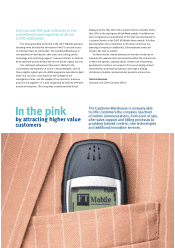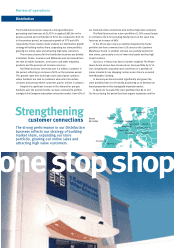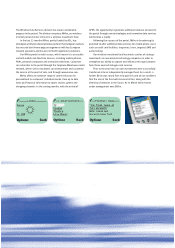Carphone Warehouse 2001 Annual Report Download - page 15
Download and view the complete annual report
Please find page 15 of the 2001 Carphone Warehouse annual report below. You can navigate through the pages in the report by either clicking on the pages listed below, or by using the keyword search tool below to find specific information within the annual report.
The Carphone Warehouse Group PLC Annual Report 2001 13
Cash and short-term investments 2001 2000
£m £m
Cash 67.5 25.3
Overdrafts (10.4) (15.4)
Bonds and FRNs 16.3 5.9
Equities 21.5 3.8
Other short-term investments 8.6 1.5
Total cash and short-term investments 103.5 21.1
The Group is exposed to limited cross-border foreign currency
contractual commitments, and where these commitments are
significant they are hedged at inception by forward currency
contracts. We aim to protect overseas subsidiary reserves from
foreign exchange losses by ensuring that at least 75% of total
overseas net assets are hedged, by way of intra-Group borrowings
in the appropriate currency and by currency swaps.
The Board’s objectives for financial risk management include
the use of financial instruments. Such instruments are used for risk
management purposes only and the Group does not trade
or speculate in any other financial instruments.
Shareholders’ funds and return on investment
Profit for the period attributable to shareholders was £38.2m
resulting in total shareholders’ funds of £436.8m at the period
end. As in previous periods the Board has decided to retain these
earnings for continued investment in the development of the
Group and the future enhancement of shareholder value and
is not therefore proposing a dividend for the period.
Financial controls
The management structure of the Group ensures day-to-day
financial controls are the responsibility of local operational
managers whilst continued adherence is ensured by Group
monitoring. Comprehensive systems of budgetary control are
in place, with regular reporting to the Board. During the period the
Board reviewed systems of internal control to ensure compliance
with the Turnbull guidelines.
The internal audit department reports to the audit committee
three times a year and reviews all key business units over a rolling
3month cycle.
Euro
The introduction of the Euro will affect the Group whether or not
the UK participates in EMU. Our business operates in eight of the
first wave countries who will themselves be transacting in Euros from
1January 2002. The remainder of the Group will also find
themselves transacting in Euros. As such the Group is taking all
steps felt necessary to ensure that it is well placed to conduct
relevant activities in Euros.
Accounting standards
During the period a number of Financial Reporting Standards
(FRSs) were issued. These have been implemented where required
together with adherence to Urgent Issues Task Force (UITF)
requirements.
The accounting policies adopted during the period are set out
on pages 30 and 31 and are consistent with those applied in the
prior period.
Roger Taylor
Chief Financial Officer
Interest and tax
Net interest receivable of £2.4m was generated in the period,
reflecting the Group’s strong net cash position. This compared
to an interest charge of £0.2m in the previous period.
The effective tax rate before amortisation and exceptionals for
the Group for the period to 31 March 2001 was 20.2% compared to
31.7% in the previous period. This rate benefited from the use of
prior year tax losses and the effect of the profit within the Group’s
offshore insurance business.
Goodwill amortisation
Goodwill of £211.6m arose during the period, of which £169.1m
was as a result of the restructuring of minority interests prior to
the Group’s flotation. The amortisation charge for the period was
£8.8m of which £6.0m relates to the above restructuring and for
which there was no charge in the prior period.
Earnings per share (EPS)
The Group’s basic EPS rose by 85% from 2.7p to 5.0p. EPS before
amortisation of goodwill and exceptional items rose by 42% from
3.8p to 5.4p per share.
Balance sheet and cash generation
At 31 March 2001, the Group had net cash and short-term
investments of £103.5m. This has been due to our ability to
generate cash from operating activities and the raising of £187.1m
from the issue of shares in the period. In turn £109.3m has been
invested in acquisitions and capital expenditure on converting
stores into the Group’s brand and on our operational
infrastructure. Our working capital management is closely attuned
to this aim of cash generation and our cash conversion ratio is
monitored closely.
In addition, the Group invested a further £31.4m in the
Wireless Internet fund.
Cash flow 2001 2000
£m £m
EBITDA 66.0 41.4
Other operating cashflows (22.3) 3.1
Cash flow from operating activities 43.7 44.5
Capital expenditure (74.0) (36.7)
Investments (31.4) (11.6)
Acquisitions (35.3) (25.2)
Tax and interest (4.6) (7.6)
Issue of shares 187.1 –
Other movements (3.1) 19.7
Increase (decrease) in net cash and
short-term investment 82.4 (16.9)
Net assets increased during the period from £43.4m to £438.4m
and the Group’s liquidity ratio increased from 1.0 to 1.4 reflecting
the strength of the Group’s financial position.
Financing and treasury
Our business is currently financed entirely by retained profits and
equity. The Group does have a multi-currency 3year Revolving
Credit facility of £150m expiring on 14 April 2003, of which
£10.5m was utilised for guarantees at the period end. Funding of
our subsidiaries is, apart from local overdraft facilities, arranged
and monitored centrally and on an arm’s length basis.
In the absence of significant debt within the Group, liquidity
and interest rate management is concentrated on maximisation
of in-hand funds through good day to day cash management and
maximisation of our return on such monies, ensuring at all times
that investments are within acceptable risk parameters.
























